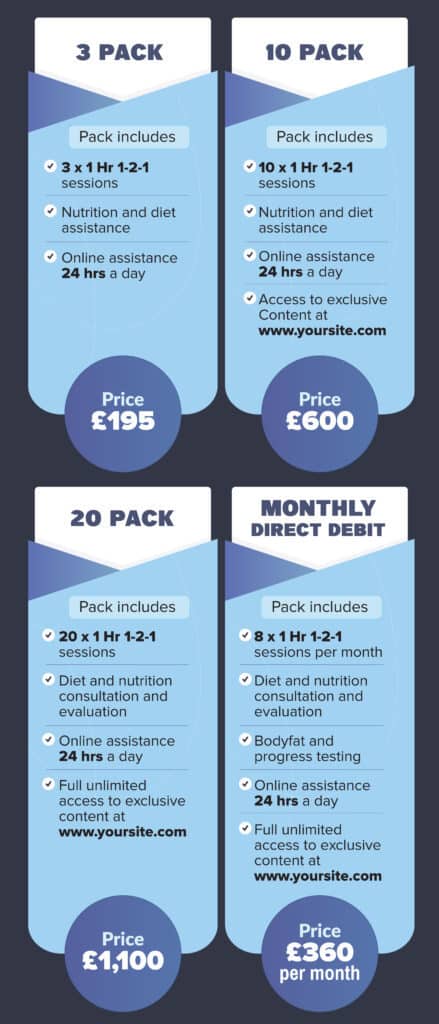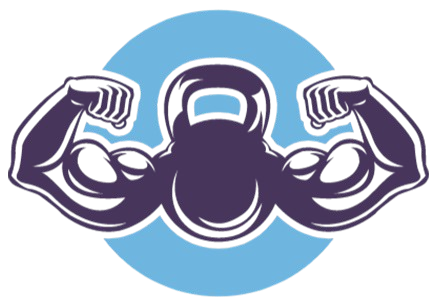Fitpro Income
How To Create, Price And Sell Personal Training Packages
Let’s face facts, selling personal training is hard!
You’ve nailed your comp session, you’ve built so much rapport that you’ve already been invited to Christmas day dinner and you know that you’re going to get on like a house on fire with your prospective client.
There’s just one thing in the way, you’ve gotta sell them your sessions.
In this article, I’ll be running you through everything you need to know about creating a personal training package, and how to make it so awesome that the sessions will sell themselves and do all the hard work for you.
And if you’ve been wondering “how much should I charge for personal training?”, don’t worry, I’ve got you covered there too.
Sound good?
Let’s go……..
Personal training package example

How do you create a personal training package?
The most important point about PT packages: You’re selling a product, not your time
I’m going to start where I think 90% of personal trainers go wrong with selling sessions, and it’s killing their businesses!
The vast majority of PTs I’ve seen in my time in the industry have personal training packages that simply list blocks of sessions (10,15, 20 sessions, once, two, or three times per week, etc) with the length of each session and the price next to it.
Tell me what’s exciting about this……….no honestly, please if you can find one thing that would genuinely make you be interested in signing up with a trainer based on their package options alone, what would it be?
You see, that’s the problem, these trainers are selling their time, by saying “in order for you to have the honor of training with me for an hour three times a week, it’ll cost ya this much”.
I hate to break it to you, but your clients don’t really give a damn about your time, what they care about is the result they can get, what they are going to achieve from hiring a personal trainer.
Remember, personal training is not cheap, it’s a luxury that the majority of people out there will never be able to afford, to the few who can, you’ve got to show them the benefits of what they are paying for.
And I can guarantee you that even if you’re the funniest, most amazing PT around, they aren’t paying for your company.
So what should you do instead?
You’ve got to sell a solution, something they can feel, see, and measure.
For instance, let’s take the traditional “10 pack”, a block of ten sessions with each session usually being an hour long.
That’s dull as dishwater, and what you’re trying to do here is sell the product you’re offering, so why not spice things up a little and actually start selling?
Instead, replace that boring block of ten sessions with a “6-week fat loss transformation package“, something with a little more zing and pizazz.
You’ve got to get yourself deep in their mind, what would make you want to part with your hard-earned cash?
If you don’t consider yourself a master of marketing, that’s not a problem, no need to panic. Just try to show a person what they can gain from your sessions.
Such as:
“6-week fat loss program“
“8-week muscle-sculpting options“
“12-week beach body transformation”
Sometimes, simple is best, so if you don’t want to go too overboard with your personal training package names, just make sure you do one thing, make sure they sell a benefit.
I’d stay away from giving any exact numbers because every person you meet will be different and will respond to training differently.
There’s no way you could estimate what all your clients will be able to achieve, so keep it exciting, but still fairly broad.
A word of warning
Only offer what you can realistically achieve!
It might be really tempting to put something crazy like “guaranteed weight loss in 6 weeks“, into your sales packages to try to increase the number of signups to your program, but can you actually deliver this?
If you can’t, don’t say it, simple as that.
The last thing you want is a ton of people asking for their money back because they only achieved half of what your program said they could.
Much as we are looking at the marketing aspect of selling personal training packages, you should remember that what you are asking people to sign is a contract. That means you’ve got to deliver what it says on that page, and if you don’t, they are able to get a refund.
Keep things exciting, but only offer what you know is possible in the timeframes you’ve put together.
Let them know exactly what they are getting

So by now we’re selling a product and the outcome, and we’ve (hopefully) done away will selling blocks of time, that’s great, but what do we have left?
What is that person actually going to be getting from your training?
If it’s purely the fact that you’d be standing next to me watching me lift weights up and down and saying “good” every now and then through a set, that still wouldn’t make me want to spend money on your training.
Instead, make it completely clear what they are getting from your services as a whole.
Here’s a few examples of what you can say each particular packages includes in addition to the training sessions:
- Tailored diatary and nutritional recomendations with meal plans (if you offer them)
- Contact by phone/email 24/7 (don’t panic, no one ever called me at 2am)
- Training programs for use outside of training sessions
- Monthly progress tracking
And so on, hopefully, you get the idea by now, people are driven into making a purchase when you provide benefits, and the more you can offer the better.
Just remember to only offer what you can actually provide.
Keep the options simple and limited
What’s one of the worst things you can do when writing up your package options?
Giving way too many choices
This may sound contradictory to what I’ve been saying so far, but hear me out.
There’s a wonderful phrase that totally explains what happens to people when they are given too many choices and can’t pick out a single one, and it’s called “analysis paralysis”.
Put a list of twenty options in front of someone and they will be overwhelmed by the number of options you’ve given them, meaning they will probably feel flustered and might panic about making the wrong choice.
This will ultimately end up with them backing out of making any purchase at all.
So, to combat this, we only want to offer 3-4 options to make it quick and easy to browse each one and make an easy decision.
Let me make it clear that there is nothing wrong with adding plenty of benefits into each of these options, but the number of actual training packages you offer should be kept to a minimum.
How to sell your personal training packages

Down to the nitty-gritty, the good bit, the actual sales process.
The biggest benefit you have by creating a clear and simple training package options page is that it does all the selling for you. You won’t have to remember your prices, what your offering, or anything, you just show them what is essentially a menu of what they can purchase from you.
Here’s the step-by-step process I used to use to get new clients.
Step 1. Sign prospective clients up for a complimentary session.
Step 2. Give them a fantastic workout/fitness assessment.
Step 3. Take them away from the gym floor and have a brief chat about how they felt the session went.
Step 4. Show them the personal training options page I created and let them read through it.
Step 5. Asked them out of the options available, which one they would like to go ahead with.
It’s a pretty brazen approach, but you’ve got to be a bit authoritative in this situation. You also need to prepare for people to turn you down, there’s plenty of people out there that just wanted to see what a session with a PT would be like and plenty more that realise they can’t afford to train with you.
There’s nothing wrong with this, it’ll happen plenty of times, no PT has a 100% conversion rate on comp sessions, so don’t let it get you down. Just book in a few more and keep your chin up.
Here are a few personal training packages examples to give you an idea of how yours might end up looking and to give you a little inspiration.

Let’s break down what I did here.
First of all, you will see that I have four options available, which remember is the maximum you should be offering.
We have the traditional blocks of sessions available as the first three (I know I said don’t sell blocks, but bear with me because it gets clever).
Each option clearly states its price, how many sessions, and for what duration along with the additional benefits the customer would get from the package.
Now, if you read each one, you’ll see that as the number of sessions and the price increases, the more benefits the customer is offered.
In terms of price, the smaller the number of sessions in a block, the more expensive it was. This is fairly standard practice, you’re essentially getting a discount for “buying in bulk”.
But here’s the crazy thing!
I didn’t want to sell any of those blocks, remember blocks of sessions are what I said was killing PTs businesses.
What I wanted to sell was the option on the right, the last one a person’s eyes would be drawn towards as they read from left to right.
That’s why I made the blocks of sessions deliberately more expensive than the monthly sessions, and nearly priced myself out of the market with them. I wanted to make the blocks unappealing, and the monthly option the clear winner in terms of value.
The monthly training packages are what let me create and maintain a profitable personal training business for years.
Monthly renewing training packges will explode your busines!
One of the main drawbacks to selling blocks of sessions is that you are constantly having to sell and then re-sell to your clients. As soon as a block is complete, you’re going to have to ask your client if they want to buy another one, and this never ends.
Every block could be their last, especially if they are looking at them as being “lessons” which is more common than you’d think.
When someone sees your sessions as “lessons”, it means they are looking to stop once they feel they know enough about how to train, and this is not good.
Instead, you should do everything you can to show your prospective (or current) client the benefits of training on a monthly basis, and using the training plan as you see on the far right of the template is a great way to do this.
The easiest way to do this is to make your monthly training option without a doubt the best possible in terms of convenience and affordability.
It’s pretty important that you either explain or show on your page that there is a minimum of three months of training to be able to take up this offer. This way, once a client has signed up with you, you know that you can rely on their income for a quarter of a year.
Having this kind of predictability and reliability is very rare in the personal training world, and if you’re selling blocks of sessions, you’ll probably never get it.
You can also stipulate that all sessions must be used within the month they were purchased, and cannot “roll over”, which also means you’re guaranteed a certain number of sessions each month.
Trust me, once you’ve started selling personal training monthly packages, you’ll wonder why you ever used to use blocks.
Pricing personal training packages

No matter how good your sales techniques or presentations are, if you price yourself out of your local area, you won’t sell sessions, or at best, you’ll only sell a few.
What you want as a trainer, is a nice, consistent flow of clients, and your personal training package prices will help you win this.
So, how can you write up a sales presentation package with a pricing structure that keeps you in business, makes you a decent profit, and doesn’t make your prospects run a mile?
Here’s the first thing I would say.
Making your sessions dirt cheap, is a terrible idea!
The downfall of many great trainers is their belief that if they make the sessions cheaper than all their competitors, they will surely have an easier time picking up clients?
Well, no, it just doesn’t work like that.
By making your sessions too cheap, you are causing yourself two problems.
- You are underselling yourself
Making your sessions cheaper than the other PTs in your gym or local area will usually make people suspicious of the quality of training you provide.
After all, why should you be cheaper? Are you not as qualified? Are you new to the industry, or worse, are you desperate for clients because your business is failing?
These questions may sound harsh, but it’s how people really think, and the conclusions they will quickly jump to.
If we take the example of two restaurants, one selling a steak at £20 ($26) and the other priced at £10 ($13.40), you’d almost certainly wonder why the second restaurant could sell you such cheap steak.
Is it because it’s cheap meat that won’t taste good? or have they had bad reviews and are desperate to get new diners?
It doesn’t matter if, in fact, the restaurant has a supplier that can source the same meat as restaurant one at a cheaper rate, such a massive discount with no obvious reason why will always raise people’s suspicions.
- You are making yourself tons of work
Even if you do manage to pick up clients with your discounted rate, you are going to have to complete far more sessions than the other PTs around you to make the same kind of income.
The cool thing is, I’ve actually made this mistake myself.
I thought if I made my sessions nice and cheap, it would be much easier to convert clients and get those all-important sessions booked in, and much as I did pick up a few extra clients this way, it gave me nothing but trouble.
I had clients that canceled more often, would not accept that they had lost sessions if they didn’t give me enough notice of needing to cancel, and to make up for the loss in income, I had to extend my working day by several hours.
In short, it did no good for my business, gave me poor quality clients, and made my social/home life non-existent.
It’s just not worth it, and as soon as I realised this, I put my prices back up, started making money again, and even got my social life back.
How much should personal trainers charge?
For easy ways to determine how much you should be charging for your sessions, take a look at these quick tips.
- Scout out your competitor prices
The first and easiest thing you can do is to take a look at what your competitors are charging.
Try to find out the highest and lowest prices other PTs in your area or gym are charging, and you’ll know where you’ll know the kind of prices people in your area expect to be paying.
This stops you from either pricing yourself out of your area or drastically undercharging for your services.
2. Make sure you’re covering your costs
Whatever location you work, if you’re paying rent to a gym, park. or visiting people’s homes, you’re going to have costs to cover.
Make sure that you are charging enough for each session to at least offset your costs each month. This should be a bit of a no-brainer, but a lot of new PTs don’t realise just how much rent gyms can charge their trainers, so make sure that your rent or expenses are actually being covered by the prices you charge for each session.
For example, if your gym rent is £1000 ($1340) a month (which is standard price for gym rent in London), then you’ll want to get that covered within the first few weeks. That’s why the standard price for personal trainers in London is around £50-60 an hour.
At this rate, a trainer will have their monthly rent covered after completing 20 sessions, or just 4 sessions a week, the rest is going to be their actual income.
3. Know that what you can offer is worth the price you charge
A common mistake by new trainers is to undercharge for their sessions due to a lack of confidence.
Trainers freshly out of their training academies sometimes feel they have no place charging the same amount as trainers with far more experience.
This is not true at all, and it won’t help your business.
All you are going to achieve with this is to make it perfectly clear that you doubt your own abilities and your worth as a trainer.
Being a successful trainer comes down to having the confidence that you know what you are doing, and being able to express that to your clients and prospects through your body language and general self-confidence.
Set your prices to show that you are confident that you can help people reach their fitness goals efficiently, effectively, and safely.
4. Be willing to be flexible
I need to make it very clear that by “being flexible“, I do not mean lowering your prices to cater to people who can’t afford your standard sessions, as previously discussed, this is a slippery slope that can lead you to drastically undercharging for your services.
Instead, be a little creative and give more options for people who have said they can’t afford your 1-hour sessions, (and trust me, you’ll hear this a lot).
If after you have shown your pricing package you’ve been turned down due to price, you can offer the half-hour sessions. So instead of charging £50 ($67) for an hour, you can charge £30 ($40) for a half-hour session.
This still makes you plenty of profit, and if you can get two half an hour sessions back to back, you will be making more than your standard 1-hour sessions.
Your client can afford the sessions and you make more money per hour.
It’s a win-win scenario!
5. Consider your level of experience
Have you taken additional courses? Extra qualifications? Can you offer something that no other trainers can in your gym or area?
If so, there’s no way you should be charging the same amount as the people that are freshly out of PT school.
If you can offer an exclusive product that can’t be matched by your competitors, you should be charging extra for that. After all, you spent the time and money to get those extra qualifications, and as a result, you will probably be providing a much better service, so your clients should definitely be paying more for your sessions.
Don’t feel guilty about charging extra, you worked hard for it and a premium product deserves a premium price structure.
What about online personal training packages?

The rules for pricing your online personal training package ideas follow all the same processes as mentioned above.
The slight difference is that as you will be working with clients online, they will not be benefitting from 1-2-1 training with yourself in person.
As a result of this, I don’t believe you can charge as much as you would a physical 1-2-1 session, however, you should still charge exactly what you’re worth, what other online trainers are charging, and still charging extra if you can back yourself up with additional qualifications/expertise.
You’ll still have costs, even as an online trainer, and you’ll still need to make enough profit for it to be considered a career, so do not undersell yourself.
The added benefit you’ll have training people online is that you can be training multiple people at once, which is an excellent use of time.
The average cost of a 1-2-1 physical personal training session in the UK is around £50-60 an hour, that’s around $67 or so dollars in the US. A fair and realistic cost for a one-hour online training session would be around £30-40 ($40-50).
Conclusion
So there you go, by the time you’ve finished reading this article, you should have a pretty good understanding of how to create, price, and sell your personal training packages in a way that makes them almost sell themselves.
I’ve used these techniques for nearly a decade to grow and maintain a successful training business in the middle of London, and if it worked for me, it can work for you too.
I hope you’ve enjoyed reading this article, and more importantly, I hope it helps you pick up a ton of personal training clients.
Go get ’em!
